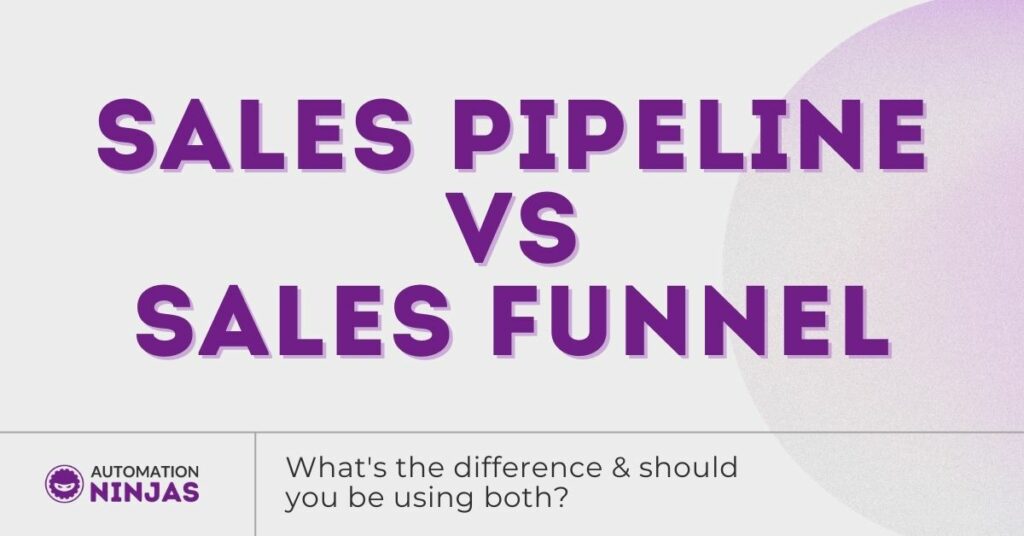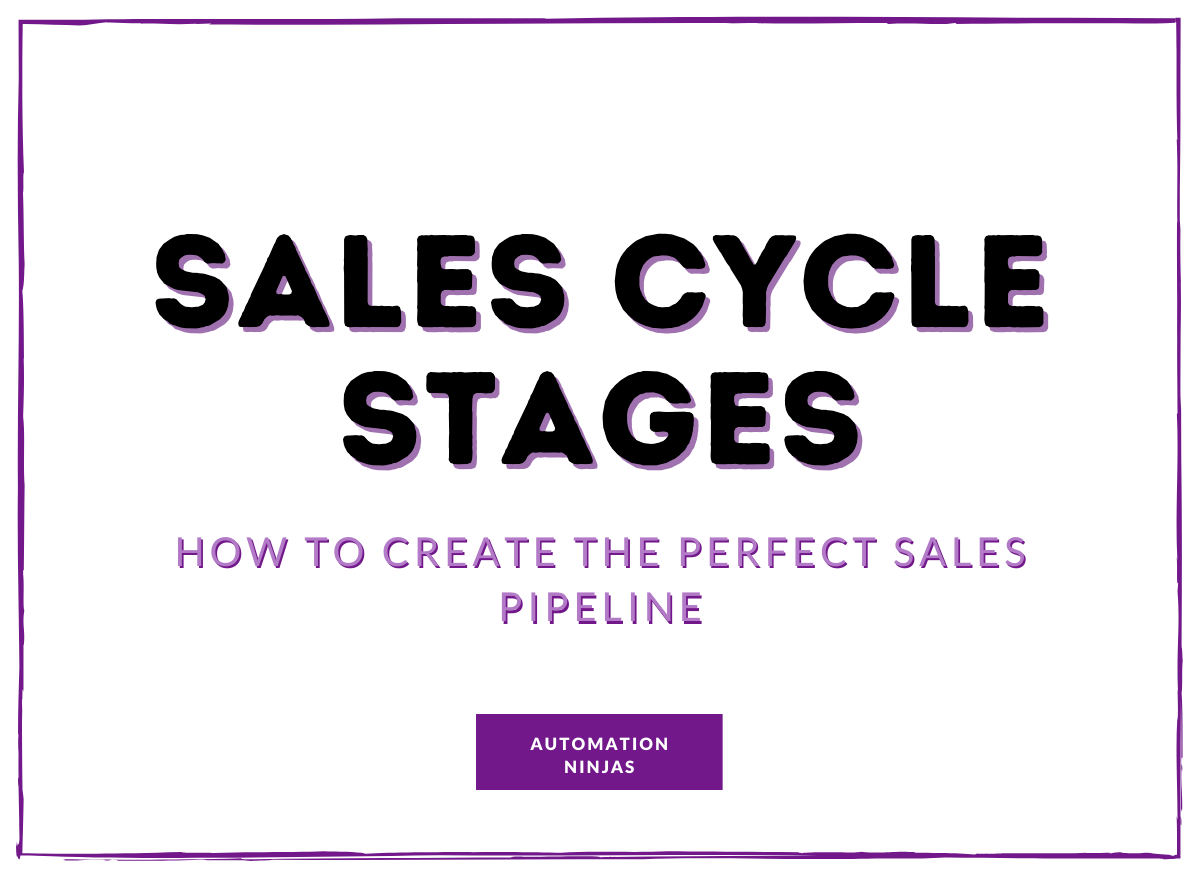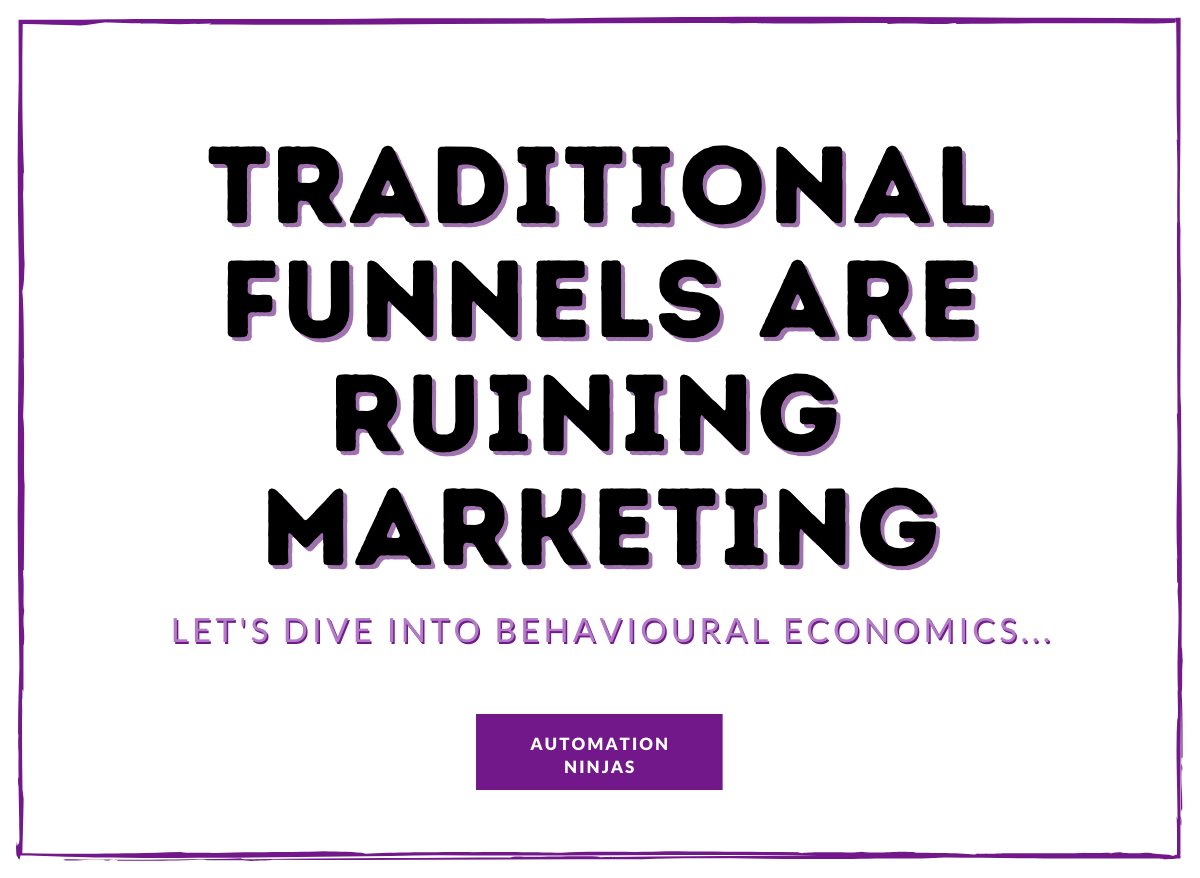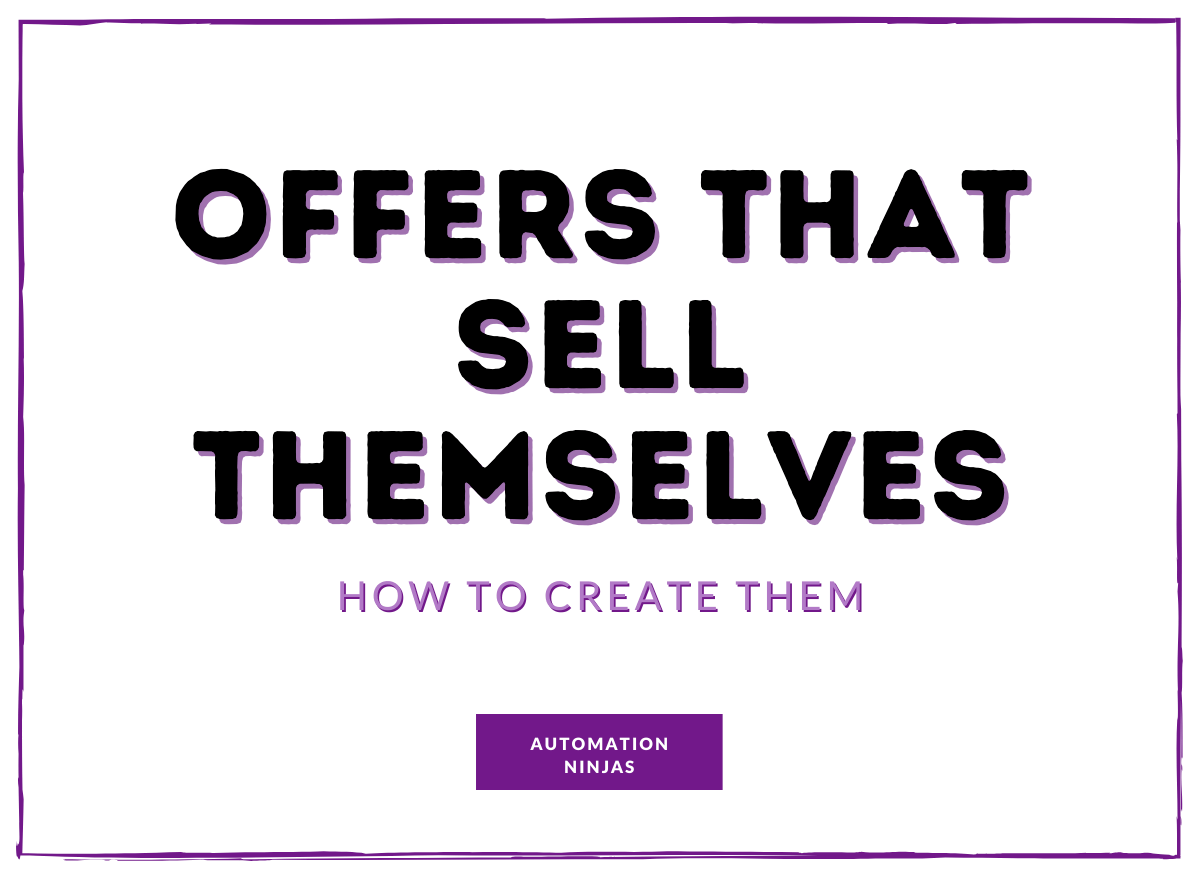The sales pipeline and the sales funnel are two systems that will help your business make sales. However, they often get mixed up or are simply considered to be the same thing. So, what’s the difference?
We’ve built many successful pipelines and high performing funnels for our clients. This blog will dispel any confusion you might have between the two and help you decide if you need one, or both of these systems.
By the end of this page, you should have a clear understanding. This will help you to map out both systems in your business to improve your sales process.
This information will be useful if you’ve been selling your product/service (I’ll just use the term 'solution' to represent either of these from now on) for some time, but don’t have the process of selling nailed down.
You want to have a process that consistently produces reliable sales from a good set of prospects.
Why? Because a well mapped out process is far easier to automate than one that is just done off the cuff, and different for each sales prospect.
You probably already have a sales pipeline, but may not call it that, or it may be a bit on the random side...
What is a Sales Pipeline?
Your sales pipeline is a way of representing the distinct stages that your prospect may be at when they are communicating with your sales agents. Even if the sales team is just you, there will be common stages that you can divide all your prospects into, including the stages where you have won or lost a prospect.
As soon as a lead becomes a prospect, they enter your pipeline.
The stages for a typical business are as follows:
1. Prospect
2. Contacting
3. Qualifying
4. Making Offer
5. Objections
6. Close
In the sales pipeline, we’re not looking at all the stages that have led to the person becoming a prospect.
All the marketing and advertising is external to the named stages above. All of the delivery and follow up, requests for reviews, testimonials and referrals is all part of the sales funnel, and not the pipeline.
With the sales pipeline, we’re only interested in the stages that traditionally involve the sales team being in direct contact with the prospect.
When you have defined your pipeline, you can count all the people in each stage, and for each sales agent.
A business that has not defined it’s pipeline will have some idea of the amount of prospects that an agent is working with. As well as how many closes they have made in the last month. Yet, they may not know how many are at each stage... This makes it difficult to identify where the bottlenecks are, and where to make improvements.
Sales Pipeline Example Figures
Our example business is a landscape gardening company.
They have a team of 15 - including 3 sales agents - Clive, Esme and Malcolm.
Their sales stages are as follows:
1. New opportunity - enquiry made
2. Attempting contact
3. Consultation
4. Proposal sent
5. Contract sent
6. Contract signed - Won, or
7. Lost
Let's break these down further.
New opportunity - enquiry made
The new opportunity stage is where prospects are placed when an enquiry is made. Either through the website, by telephone, or someone dropping into the office.
NOTE: The prospect does not have to move through every stage to get to the final two stages.
A potential customer can call in, and speak to Clive straight away, doing the consultation right there and then, skipping the next (Attempting Contact) stage.
Attempting contact
If someone calls after office hours, and leaves a message, they will be in stage 1. The team leader will come in the next morning and assign that lead to one of the team, say Malcolm. He will then put them in stage 2, and try to contact them.
Consultation
This stage is for when a consultation has been booked. You can break these stages down into more detailed stages, but it’s best to keep a pipeline as simple as you can make it.
When a consultation is booked, but the prospect does not turn up, and does not answer phone calls, they may be moved backwards into the ‘Attempting Contact’ stage.
Proposal sent
Say you've sent out an initial proposal for the required works, which comes in at less than the prospect was expecting. Now they want to add a garden shed in the corner of the plot - because why not, they have the budget for it. The proposal will need to be updated and re-sent with the new plan.
You could add stages for 'Proposal Rejected' and 'Proposal Re-sent' but keep it simple first. You can always shoehorn in stages later if you need more detailed reporting.
Contract sent / signed
We have split up the 'Contract' stage into Contract Sent and Contract Signed. This is because there may be some waiting time between the two stages, where re-negotiation takes place, or a prospect gets cold feet.
Note that they don’t have a distinct qualifying stage, as this pipeline is not based on outbound lead generation, but inbound enquiries. So they have come in, probably with a rough budget in mind, and will most likely be the decision maker already.
With all of these distinct stages in place, the company can get an idea of where they are performing well, and how to improve.
They will have a report for the total pipeline, with all the prospects that have made an enquiry showing in each of the stages.
Below is a snapshot of the current situation, on the basis that all enquiries that come in are equally distributed.
The total number of enquiries received in the first quarter (Q1) is 109. There are 6 enquiries that have come in overnight (included in this total), and have yet to be distributed to the sales team. Esme has a backlog of 6 prospects that she has not been able to contact yet, Clive has 10 and Malcolm has 7.
Sales Stage | Total | Esme | Clive | Malcom |
|---|---|---|---|---|
Total Enquiries Q1 | 209 | |||
New Enquiries | 6 | |||
Attempting Contact | 20 | 4 | 10 | 6 |
Consultation | 16 | 6 | 3 | 7 |
Proposal Sent | 14 | 6 | 3 | 9 |
Contract Sent | 12 | 4 | 2 | 3 |
Contract Signed Won | 65 | 27 | 17 | 22 |
Contract Signed Lost | 76 | 24 | 26 | 26 |
Working with the Sales Pipeline
Now we have some data to work with, and we can see that there are areas to improve on.
Bear in mind that this is a snapshot of how many people are currently in a stage, during the first quarter of the year. You may track your pipeline differently, this is just a common example.
As everyone is being given the same amount of prospects, we can see that Clive could be doing better at getting people to a consultation.
We talk to Clive and Esme and find out that Clive is only calling twice before giving up, where Esme is phoning four times and sending an SMS before moving a prospect to ‘Lost’.
Our focus is therefore to help Clive drive those numbers up by increasing contact. Over the coming months he gets more consultations, and all the following stages have higher numbers as a result.
We can also see that Malcolm has 9 people in the ‘Proposal Sent’ stage. It could be that he’s not putting enough into chasing a sent proposal, and hence does not get as many contracts sent.
Remember, without these stages built out, and being measured, we only know that we signed 65 contracts since we started measuring the pipeline. We want to know if we're hitting target, getting good ROI, and how to forecast for the coming months/quarters.
Without this information, we might decide that we need to just throw more money at adverts in the local papers, or reduce our prices to beat the competition. Both of these would be a bad decision, costing us more money than we need to spend as we can improve conversions through improvements in the pipeline.
What are the key features of a Sales Pipeline?
- Visual way of organising all your sales prospects into stages
- Usually stages that a sales team goes through
- Linear process, although people can skip parts, and can go back to a previous stage
- The ‘Buyer’s Journey’
- Basic process is very similar for all businesses
- The same basic structure for all prospects in the business
- Based around a sales team that calls/emails directly
- Mostly outbound
- Aligns sales teams
- Drives people from prospect to sale through personal relationship building
- Often managed within spreadsheets
- Better managed in a CRM (Customer Relationship Management) platform like Salesforce, HubSpot and even Trello
- Sales forecasting tool
What are the benefits of a Sales Pipeline?
- Track numbers at each stage - deals in progress, value of deals
- Shorten sales cycle by dropping unsuccessful elements - simplify it
- Know if you’re on target this week/month/quarter/annum - conversion rate
- Can be visualised and compared to previous periods
- Easier to train new staff - hone your sales process and don’t miss steps
- Helps maintain quality consistency
- Compare sales agent success - help improve other agents
- Improve the experience for the customer
- Predict revenue based on previous and current performance
- Keep track of cash flow, to plan sales and marketing drives
- Ability to track and record data on prospects
- Allowing you to refine your process and recognise good and bad prospects
- Track which stages are losing customers
- Keep track of those that are not ready to buy now and may buy later
- Track factors in sales failures and successes
- Helps you build your customer profile for better sales and marketing
What is a Sales Funnel?
Your sales funnel is a framework that contains everything that you are doing to attract leads to a particular product and convert them into customers.
It includes your advertising, your marketing and all that great networking you do. From the initial touch point, to lead qualifying, conversion and new customer follow up.
A visual representation of your sales process, it’s called a funnel because it looks like a funnel.
The widest part at the top represents the number of people that would be in that stage, compared with the number of people that progress through your other stages. Reaching the final and much smaller bottom stage, where they have bought your product, and ideally become business advocates.
As opposed to the sales pipeline, the stages are not a simple linear process, as you may have many different tactics in use, that drive a lead to become a prospect, to build trust and engagement, and even negotiate upsells and cross-sells where a purchase has been made.
It is a basic Customer Journey for your solution. When building out the complete customer journey, you can bring in other solutions to complement or to substitute the one in question. Perhaps one more fitting to the prospects requirements.
The sales pipeline, detailed above, is all based on personal contact from your sales team, meaning that there is a limit on how many people can be interacted with each day. However, the sales funnel, if automated well, can handle as many prospects as your software will allow, and prospects can be at a great many points in your funnel.
Sales Pipeline vs Sales Funnel - Working Together
A key feature of the sales funnel is that it can include your sales pipeline.
For example, if you are selling a service, and there is a high volume of search traffic available, you may be running Google Ads for the keywords. You're taking people to a landing page with a video on it explaining how to choose the best service, then getting people to opt in for a PDF that explains in more detail.
FYI - this is called a lead magnet / gated content.
People downloading that PDF may be sent to the sales manager’s inbox and therefore enter their sales pipeline at the New Opportunity stage. The sales manager will distribute the leads to the team, who will put them into their own Contacting Silo.
All the interactions that happened prior to the sales manager receiving the lead are not in the pipeline. However they are part of the sales funnel, and there could be many other elements that are put in place to find and collect leads for the pipeline.
A sales funnel is typically split out into three or four stages, and the most common stages are Top Of Funnel, Middle Of Funnel, and Bottom Of Funnel (ToFu, MoFu and BoFu).
These stages are most useful when used with audience awareness levels in mind.
Sales Funnel Stages - ToFu, MoFu & BoFu
The people you are trying to attract into the top of the funnel are at a low awareness level. They may not know who you are, or that they have any need whatsoever for your solution.
This is where you will put all your social activities, PPC, your basic website content, blog etc.
The middle of the funnel is where you put more in-depth information. Your leads have now become prospects and will be interested in your informative videos, your long-form content and downloadable PDF’s or free short courses.
The bottom of the funnel is where you put your most persuasive content, dealing with objections, virtually negotiating, and where your sales team may come into contact with your prospects.
Throughout the funnel, your marketing systems can be gathering information on your prospect and measuring their engagement with your content. And we all know that knowledge is king.
With more knowledge about your prospect, you can tailor content that is right for them. With good reporting on the success of your marketing tactics within your funnel, you can be improving and optimising much faster than it would take you to optimise your sales team!
Your sales funnel is the overview of your customer journey.
The customer journey is often a much more complex beast, with many moving parts, and should be mapped out using flowcharts.
The reporting on your sales funnel can have a high-level overview, and can also be broken down into the tiniest parts if necessary.
On an overview level, you could have the following numbers, looking at the past 30 days:
ToFu | MoFu | BoFu |
|---|---|---|
Website Visitors: 4500 | Newsletter Sign Ups: 30 | New Customers: 15 |
Facebook Ad Impressions: 250 | Facebook Sign Ups: 50 | |
LinkedIn Requests Sent: 30 | LinkedIn Connections: 12 |
A small section of the middle of the funnel may include the following results for a newsletter sign up form that is in an ‘exit intent’ popup on your website:
Newsletter Pop Up Impressions | Newsletter Sign Ups | Newsletter Email Opens | Newsletter Emails Clicks | Requested Consultation |
|---|---|---|---|---|
150 | 30 | 20 | 5 | 3 |
Or the following report, where a Facebook advert is giving away a short video course:
Facebook Sign Ups | Course Delivery Email Opens | Email Clicks to Video | Videos Watched to End | Requested Consultation |
|---|---|---|---|---|
30 | 25 | 15 | 10 | 7 |
What are the key features of a Sales Funnel?
- It contains everything you are doing to convert leads into customers
- Starts with a visual representation of a funnel
- Widest at the top to represent the biggest amount of people at the entry stage
- Narrow at the bottom to represent how many people get to the buying stage
- Often split into Top Of Funnel, Middle Of Funnel, and Bottom Of Funnel (ToFu, MoFu and BoFu)
- ToFu is often Advertising and Marketing, MoFu is more education and sales related, and BoFu is where people become customers and receive customer follow up
- An overview of the ‘Customer Journey’
- Includes the sales pipeline and complements it
- More based on awareness stages than sales team progress stages
- Intent on capturing and keeping attention
- Can collect information on the prospect
- Can be used to answer questions and qualify prospects before sales team contact
- Has more steps and processes than sales pipeline, and greater variation
- Drives people from prospect to sale through a mix of personal relationship building and content
- May use many different platforms for collection, hosting and delivering content. Website, email marketing software, advertising platforms, SMS, retargeting
- Includes marketing and marketing automation
- Contains tactics that like lead magnets, video series, webinars & events, and email campaigns
- Inbound and outbound
- Can be used to segment customer types
- Best managed through a sales and marketing automation platform (either including or linked to your CRM system)
What are the benefits of a Sales Funnel?
- Gives you the ability to scale without adding more staff
- Track numbers at each level of engagement with your content
- Reports are often easily available and automatic
- An opportunity to take advantage of new and engaging platforms, channels and content
- Easy to pick and mix different tactics and integrate new information
- Content can be used at any stage in the journey to build engagement and build relationships
- Complements the sales pipeline
- Can track behaviour and engagement to build profile of prospect
- Allows you to answer questions and provide information to prospects at the right time in the journey
- Builds relationships without need for valuable manual steps
- Can be automated
- Follow up on people that take certain action - behavioural marketing
- Get higher qualified leads to your sales team
Sales Pipeline vs Sales Funnel - Remember the Differences
Sales Funnel is a visual overview of all your sales and marketing efforts for a solution.
Sales Pipeline is the stages a prospect goes through, usually with your sales team, to get to the point of sale.
You may not need a sales pipeline, depending on what you are selling, and if you have a sales team in place, but you certainly need a sales funnel.
A quick exercise for you:
Jot down everything that you are doing within the framework of ToFu, MoFu, and BoFu and plan out your current and ideal customer journey!

Sign up to the Brainbox to stay in the loop with the latest marketing news and exclusive content
Or, if you have something specific in mind, reach out to us directly. We're all ears and ready to chat! Contact us here.





